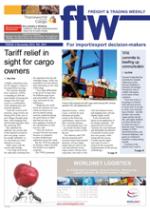A highly contentious issue
for SA shippers is likely to
be eased before too long.
The Transnet National
Ports Authority (TNPA)
is intending to shift the
main burden of paying port
charges from the cargo
owner to a combination
of the shipping lines and
terminal operators.
Under the current tariff
structure, cargo owners are
bearing 61% of the cost of
port charges through cargo
dues, while shipping lines
and terminal operators share
the remaining 39%.
But, admitted the
authority, the current split
of the required revenue by
port user group “cannot
be soundly defended”, as
it is not based on a clear
allocation of assets.
Other issues with the
current split include:
* Very high tariff levels
for cargo dues resulting from
the migration from the old
wharfage charge, which was
calculated on an ad-valorem
basis depending on the value
of the cargo;
* Very high differentials
in the levels of cargo dues
for different cargo types
and commodities with no
clear motivation for the
differences;
* Relatively low tariff
levels for maritime services,
which are based on an
activity-based costing
exercise conducted during
the tariff reform of 2002
and that has since not
been updated, resulting in
the subsidisation of some
services, and;
* Very low levels of
revenue from the real estate
business as compared
to other landlord port
authorities across the world.
But the TNPA has adjusted
its formula, which will shift
this burden to its rightful
recipients.
The TNPA’s proposed
required revenue – which,
it says, is driven by asset
allocation principles –
results in the following
contributions: cargo owners
46%, terminal operators
33%, and shipping lines 21%
– an overall reversal of split
to 46% cargo owners to 64%
the rest.
The authority told FTW
that the proposed tariff
structure means that terminal
operators will pay higher
rentals that are more in line
with international norms;
cargo owners will pay lower
cargo dues, also more in line
with international norms;
and shipping lines will pay
slightly higher tariffs.
It also insisted that –
based on the application of
the design principles – the
proposed tariff structure
“presents the most balanced
and defendable distribution”
of required revenue across
port user groups, while
noting that the success
of achieving the higher
real estate revenue is
critical for the successful
implementation of the pricing
methodology.
The TNPA listed the
principles and rules on which
the proposed cargo dues tariff
structure will be based:
* There must be a clear
rationale to justify overall
cargo dues. In the proposed
tariff structure, cargo
dues pay for the provision
of common wet and dry
infrastructure and must
recover the required revenues
from this infrastructure;
* There should be one base
rate per each different cargo
handling type (ie, containers,
dry bulk, break bulk, liquid
bulk, ro-ro), which should be
determined based on the userpays
principle;
* Users of the common
infrastructure are vessels;
therefore usage by different
vessel types for each cargohandling
type seems the most
appropriate way to determine
the charges.
To achieve this last
condition, said the TNPA, the
proposal is to determine the
share of total cargo dues to be
paid by each cargo-handling
type through the count of
vessel arrivals. For example,
44% of all relevant port
calls are made by container
vessels. Accordingly, 44% of
the total cargo dues should be
recovered by containers.
While this welcome
proposal for the shippers of
this country may depend
somewhat on the fate of the
2013/14 tariff application
at the hands of the Ports
Regulator, there is no doubt
that it will meet with approval
from cargo owners who have
for years disputed what they
felt was an unjustified burden.
CAPTION
In terms of the proposed new tariff, cargo owners will pay 46%, terminal
operators 33%, and shipping lines 21%.

